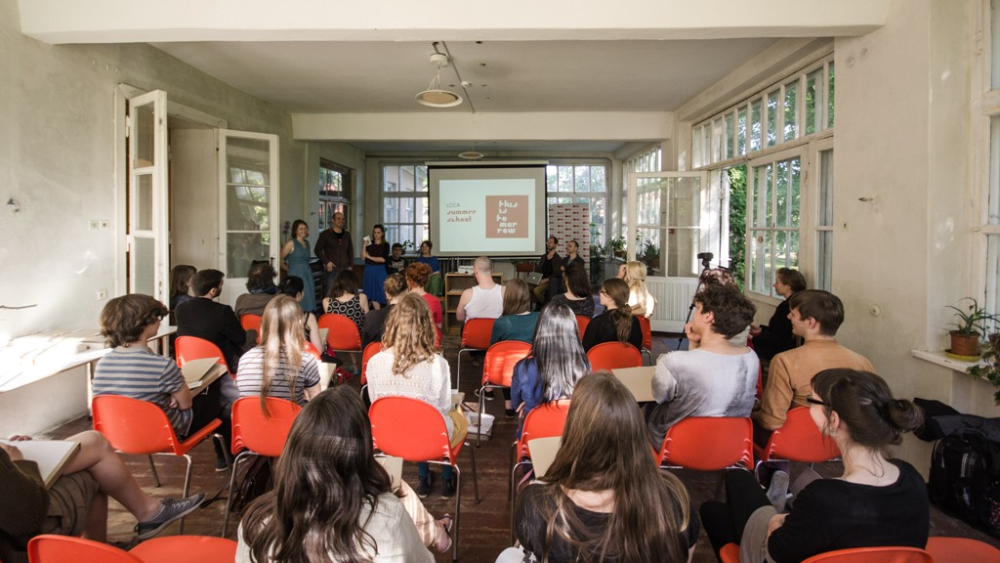Some thoughts after the Second LCCA Summer School “This is Tomorrow!” in Cēsis (6 – 11 June, 2015)

LCCA Summer School “This is Tomorrow!”, 2015, photograph by Raitis Zeiferts.
There is, of course, a certain amount of expectation and prejudice before attending academic endeavours organised in a group. The summer school in Cesis with its broad subject of tomorrow filled me with an expectation of topics such as utopia-dystopia, sci-fi, revolution, change. Subjects and discussion pertaining to revolution and change interest me and, as a self-aware idealist, I believe this is what art is capable of when it is at its best. Therefore, I am let down by the way that these grand ideas of social change and revolution, all too often, hit the brick wall of academic method and theoretical realism. The tame academic exploration of such ideas drowns their purity and simplicity, which may be dismissed as naive and idealistic, but which are necessary as a target. And it is necessary for the lecturers expressing these ideas to create a link between the source material, the ‘then’, and the public, the ‘now’. If this bridge is not established, the message is ineffectual.
In universities we are often taught of these avant-garde ideas and of the potential for world-changing art from a distance which causes them to seem abstract. In the rather enclosed society of art education, there is little room for real revolution of thought. Presenting the theories of, for instance Bourdieu, Marx, Sartre or Derrida, are not avant-garde or even contemporary in the same way that the films of Stanley Kubrick, art of Andy Warhol or the music of John Cage are neither of those things without a critical education. The academic system harnesses conservative academic practices, which present recent art history and theory as avant-garde art. There is often very little connection made by the lecturers between the abstract ideas of yester-year and the ‘now’ and what art should pursue. This suggests to us young, aspiring artists that these theories and recent art history are the ‘now’ of art. The emerging artists are, therefore, ready to be revolutionaries with ideas which were applicable decades ago in the ‘then’. With this faded radical approach they fit in well with the commercial and contemporary art scene, which has already harnessed the ideas represented by the young artists for commercial gain. After avant-garde art becomes tamed by the forces of capitalism, commercialising the raw purity of creation and the seeds of revolution, it becomes contemporary art – a pseudo-radical expression of the cultural ‘now’ and social modernity. Only after that, if we’re lucky, does the information trickle down through the academies and other institutions.
Therefore, the valuable lectures are invariably those which expand on the once avant garde bringing it into a modern discussion; those who managed to create a bridge between the theoretical message and the real world ‘now’. After all the ground work has been done in educating us about what has gone before, the ex-avant-garde ‘then’, so to speak, we are capable of creating the ‘now’ (which in the perspective of the future is the ‘tomorrow’) and conducting a true revolution of thought.
The summer school in Cesis seemed to present the event as a multi-disciplinary collaboration between contrasting participants and a two-way communication between speaker and audience, which would result in an atmosphere of open discussion. Although these sound like positive targets, I would argue that it failed on both counts and fell into the style of universities, which one expects an event like this, away from the academies and over a single week, to actively fight against.
Firstly, the attempt to present contemporary art as a field in which there is little difference between the roles of curator, theorist, artist or even biologist, writer, economist and so on is one of great potential, but also a very vast one which is increasingly complicated to present as a whole. Although the summer school in Cesis had lecturers with various backgrounds, it is not enough to just invite various people and call the event an amalgam. Without active crossover within a subject we are basically dealing with isolated islands of thought and research. Each lecture was self-contained and any discussion or collaboration between lecturers was limited.
And this brings me to the second point. Most of the speakers were only present for the day of their own talk and often even less. This alone is a sign that the organisation of the event promoted a speaker-listener; teacher-pupil relationship in a manner which is far from egalitarian. There was very little initiative on behalf of the LCCA to incorporate the lecturers into the learning atmosphere of the summer school and, through this, to deliver collaboration on a level playing field. Although the event was presented as a two-way exchange of ideas, the open discussion was very limited. In this way it wasn’t very different to the typical university setting. The ideas and topics raised were conveyed in a linear funnel structure wherein one person imparts knowledge to a group of listeners in a one-directional flow, instead of a circular development and critical discussion, which is promised all too often.
I believe that such a collaborative approach in which lecturers are not each in their own corner supports the ideal I put forward above. In an open discussion and exchange of ideas the developed research of individuals can be imparted and built on by a collective effort towards ‘now’ and ‘tomorrow’.
In this way the summer school may have been built on an interesting and novel approach, but it fell short landing in the conservative academic setting present in every university. There are, of course, benefits that can be reaped from individual lecturers, but as a whole the outcome leaves much to be desired.
























